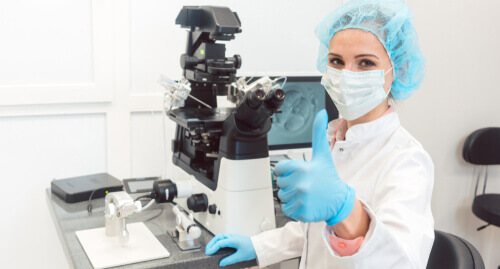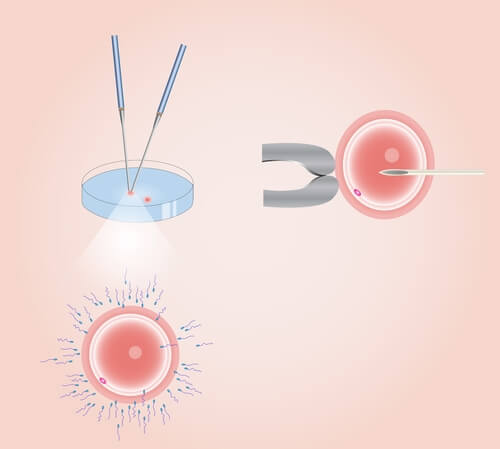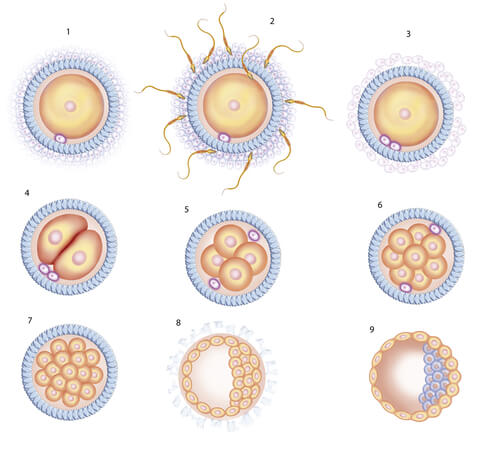In humans, natural fertilization of the egg occurs in the farthest part of the Fallopian tubes. Normally, when there is ovulation, the egg will be available to be fertilized only the next 12 or 24 hours. This process occurs on the day 14 of the menstrual cycle when cycles are regular.
Therefore, it is ideal that when this oocyte is released after the peak of the LH hormone, there are already sperm in the fallopian tubes ready to fertilize this oocyte. When the sperm meets the egg, it will first have to pass through several layers of cells that surround this mature oocyte and finally penetrate the wall of the egg called the zona pellucida and fertilize the female gamete and thus produce an embryo.
What happens if egg and sperm are not found in the tubes?
This is a very common infertility problem. Here are some of the causes:
- Either because the woman has some condition in the tubes that prevents the sperm and egg from being found inside her body.
- Deregulation of the menstrual cycle that causes the woman to not ovulate normally
- Because there is little production of sperm and they do not reach the place of foundation
- Why are man's sperm incapable of fertilizing the oocyte on their own?
Options to ensure the Fertilization procedure
In order to ensure that the oocyte and the sperm meet and the sperm penetrates into the oocyte, we only have one option, in vitro fertilization. In vitro fertilization is called that because the fertilization itself takes place in an assisted reproduction laboratory and therefore, "in vitro."
But we do not only have to do in vitro fertilization, since this procedure involves leaving the oocytes with a calculated concentration of sperm so that fertilization occurs naturally in a culture medium. Otherwise, if we want to ensure that the sperm enters the egg, we have to microinject it, and therefore, do ICSI.
ICSI is the acronym for sperm microinjection. and it is a part of IVF in which this intracytoplasmic injection of sperm is produced in the laboratory, thus seeking to ensure the in vitro fertilization rate.

Medical treatment to obtain oocytes
If the pregnancy does not occur or there is a diagnosis of infertility, it is important that you go to fertility professionals in case they consider that you should proceed to in vitro fertilization treatment.
The procedure of the Ovarian stimulation has several phases. First of all, before starting stimulation to obtain the oocytes, they will ask you for a list of tests so that both members of the couple can be studied and medical advice regarding assisted reproduction can be given. Also in this way, the most appropriate medication administration is studied for each woman's profile to stimulate her ovaries, obtaining the greatest number of eggs, avoiding complications such as ovarian hyperstimulation syndrome.
About ovarian stimulation
Once you have completed the first phases of the medical study of in vitro fertilization, the team of professionals will prescribe a series of medications to stimulate the ovaries and will ask you to attend a consultation to control the number of follicles and their growth and development. through vaginal ultrasounds.
When these follicles have grown enough and the respective control has been carried out, it will be the time to obtain these oocytes. These are obtained under sedation through ovarian puncture. What they will do is aspirate the follicular fluid where the embryologist will look for the eggs to later fertilize and evaluate the development of the embryos.

The process of in vitro fertilization (IVF) once the woman's eggs are obtained
Once these oocytes are found, they will be prepared to be fertilized with the couple's or a donor's semen. To carry out in vitro fertilization, adapted microscopes are used that allow intracytoplasmic injection of sperm from the eggs, in a controlled culture medium so that fertilization occurs and assess the next day whether or not there has been re-fertilization of the oocyte.
Once the process of in vitro fertilization with icsi, the fertilized egg or what is the same, zygotes or embryos are going to have their development, fertilization professionals are going to control their growth, development, shape, and various parameters to be able to predict which of them has better chance of generating a pregnancy once transferred to the uterus. Thus, I prepare the best culture medium conditions for the development of the embryos obtained through the in vitro fertilization process.
Conventional in vitro fertilization or ICSI?
First of all we have to clarify that when we make a In vitro fertilization is not synonymous with doing the ICSI technique, which we have mentioned is the microinjection of the sperm into the woman's egg, thus ensuring that the sperm has passed all the cells and layers of the oocyte.
The so-called conventional in vitro fertilization is one in which sperm and oocytes are brought together and fertilization is allowed to occur naturally, that is, the penetration of the sperm occurs without any human help. This method is carried out when there is good semen quality, if the couple wishes or they can even decide to carry some oocytes through this type of fertilization and others through ICSI.
The in vitro fertilization with icsi, is the entire ovarian stimulation procedure that we have mentioned and that will be the same as when we do conventional in vitro fertilization, but in this case, we add the phase of pricking the oocytes with a sperm selected by the embryologist, the reproduction professional. assisted responsible for the laboratory and the development of the embryos.

How do you see if an egg is fertilized in vitro?
In order to evaluate whether an egg has been fertilized, we we have to wait until the next day after obtaining the oocytes of the woman after extraction by ovarian puncture and after fertilizing them with sperm with or without icsi.
The way to know if the oocyte has been fertilized is by visualizing whether two pronuclei have formed inside it. These structures will contain the genetic material of the oocyte and the other of the sperm and the chromosomes are intertwined.
When the assisted reproduction professional sees these two structures, he can affirm that fertilization has occurred and will count how many embryos have been formed from the total fertilized eggs. We can only observe this fact under a microscope when there is fertilization using the in vitro technique, but the same thing happens inside the woman's body when conception occurs naturally.
Preparing the transfer of embryos to the uterus
We have to take into account that usually, the final number of embryos is not usually the same number as the oocytes recovered after ovarian stimulation and that there are several parameters that influence it.
When the embryos have reached their day 3 or blastocyst stage of development, they are ready to be transferred to the woman's uterus through embryo transfer through the vagina and depositing them inside the uterus. This process is usually quick and painless and one or more embryos may be transferred. Your medical team will discuss it with you at all times and in each phase of the cycle.
During this process, the patient recovers from ovarian stimulation and prepares for the embryo transfer. Also is true that If necessary, these embryos can be frozen and that the embryo transfer is in a cycle in which the patient has not undergone ovarian stimulation and the administration of medications.

So, if we do IVF, what happens to the tubes?
As we have seen when we do in vitro fertilization, fertilization occurs in the laboratory after ovarian stimulation. Since this fertilization is outside the body, it no longer occurs in the woman's tube. Therefore, when there is a problem with the tubes, or any previous surgery that affects them, the most common medical option is IVF in vitro fertilization.
The important thing is that the area of the uterus is evaluated by your medical team and thus be able to perform both the most fruitful ovarian stimulation possible while at the same time wanting to transfer an embryo of the best possible quality after in vitro fertilization, reducing the number of attempts and maximizing the chances of pregnancy.

If I have few sperm, can in vitro fertilization help me?
Of course. In fact, in vitro fertilization began to be developed for two specific profiles of patients, women with problems with their tubes and men with a low semen count or very little mobility.
Furthermore, nowadays, when fertilization takes place outside the woman's body, it can be given by gametes, donor oocytes or sperm. Thus allowing many couples who could not be parents to become parents and also allowing new family models.
Another group of patients who have been able to benefit greatly from this type of treatment are patients who, for a medical reason, want to select the embryo to be transferred to the uterus so that it is not affected by a serious genetic disease. In these cases, the genetic load of embryos can be studied fertilized in order to have a greater probability of obtaining a pregnancy and healthy baby.
How much does in vitro fertilization cost?
You should know that assisted reproduction treatments are treatments that require many highly specialized professionals and a very expensive material and conditions So they are not treatments that we can consider economical at all.
In addition, apart from the treatment, we must also pay for the ovarian stimulation medications.
It is important that if you are going to schedule a fertility treatment, you calmly study the budgets and assess when to do it, as well as which complementary treatments are most suitable for you.
It may interest you:

